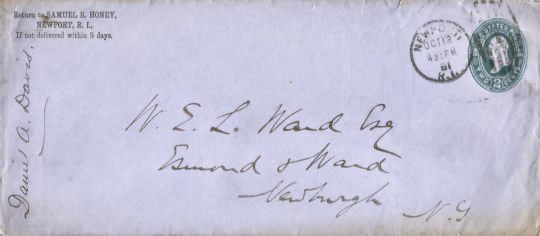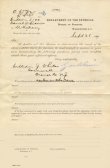![]()
Postal History Introduction
Stampless
Covers
1846
to 1900 Issues
1901-1950
Issues
1951-2003
Issues
Cancels
&
Miscellaneous
Postal
Stationery
Post
Cards
Air
Mail
First
Day &
Event Covers
Parcel Post/Special Delivery
Registered & Official Mail
Commercial & Advertising
Revenue & Postage Due
Wildlife & Game Issues
Complete List of RI Issues
|
Postal Stationary -
Embossed Envelopes and Cards |
||
|
||
|
The United States Post Office produced these stamped envelopes from 1887 to 1894. The envelope colors included white, amber, buff, blue, and manila. The two cent embossed stamp on the envelope had 3 varieties, the rarest of these was the 2 cent green on a blue envelope - Scott #U308. That stamped envelope is easily identified, as it is the only one of the three varieties where the bust points between the third and forth notches of the interior oval. The other two varieties of the 2 cent green embossed stamp with blue envelope, (Scott #U314 and #U321) are a little more difficult to tell apart, especially when the identifying marks are covered by a killer cancel such as on the cover above. However, I was able to determine that this stamp had 1 vertical bar at the corner of Washington's mouth and also that the top of the head was not as rounded as in #U321, which was enough to identify this cover as Scott #314. (Scott #321 has two bars at corner of mouth and two bars for the ear. Also the head is more rounded than on #314.)
The Return address on the cover is for Samuel R. Honey. Samuel Robertson Honey was born in England in 1842. He served in the Union Army during the Civil War and served as Lieutenant Governor of Rhode Island from 1887 to 1888. He was a member of the Democratic National Committee from Rhode Island from 1888 to 1896. He served as the Mayor of Newport in 1891 and 1892 and was a member of the Rhode Island State House of Representatives in 1893 and 1894. He died on February 17, 1927. I'm not sure what his tie-in was with the Bureau of Pensions, I could not find any reference in that capacity. In 1891 he was serving as the Mayor of Newport and perhaps a clerk in his office used the official stationary to forward this form to White's new address. The Cover was sent to Newburgh, New York which is located on the Hudson River, 8 1/2 miles north of West Point, however William White is listed on the form letter as living in Cornwall which was located 3 miles south of Newburgh. William J. White is listed on the 1864 muster for the USS Hartford as an Ordinary Seaman. He enlisted for 3 years on June 16, 1861 at Providence, Rhode Island. He served on board the USS North Carolina before reporting to the Hartford. He was born in Newport, Rhode Island, and was 29 years of age in 1861. Prior to enlisting his occupation was listed as a carpenter. He had blue eyes, light brown hair and was dark complexioned. Daniel O. Davis is listed on the USS Hartford's muster as a Landsman. He enlisted in Philadelphia, Pennsylvania on January 10, 1862 and transferred from the USS Princeton. He was born in Philadelphia and was 29 years old. His former occupation was listed as laborer. He had hazel eyes, black hair and a dark complexion. NOTE: Landsmen were new sailors who had just joined the ship and were in training to become seamen. An Ordinary Seaman was a sailor with basic training skills, but who was not fully trained in all aspects of seamanship. The next step in rank was Able Seaman or a sailor who was conversant with all of the skills required of a sailor. The USS Hartford was rated as a Screw Sloop. She was 225 feet in length overall, carried 42 guns and displaced 2,900 tons. She carried a crew of 310 officers and enlisted sailors and was capable of speeds up to 13.5 kts. She was built by Harrison Loring at Boston, Massachusetts in 1859. The USS Hartford was Admiral Farragut's flagship at the Battle of Mobile Bay on August 5, 1864. It was during this battle that Admiral Farragut gave the well known and famous command, "Damn The Torpedoes, Full Speed Ahead." It can be assumed that both White and Davis were serving on board during this time. NOTE: The Torpedoes referred to were not torpedoes as we use the term today, but rather anchored mines in the harbor. |
![]()
RI Historical Society
The Post Offices
Home Page
RI Tercentenary Issue History
RI Philatelic Society
Recently Added Pages
Philatelic Primer
Rhode Island Around the World
Rhode Island
Town Postmarks
Other Websites of Interest

